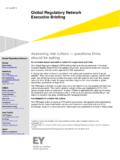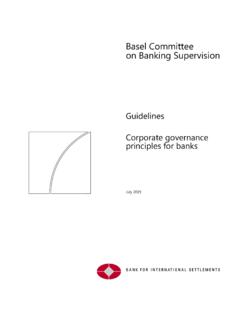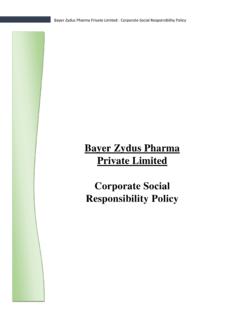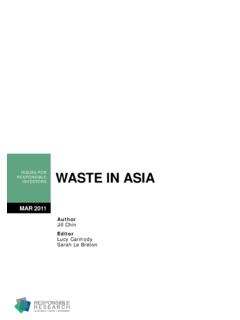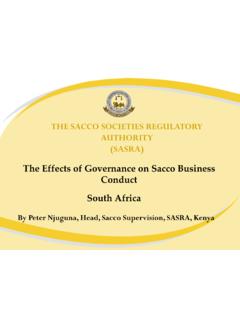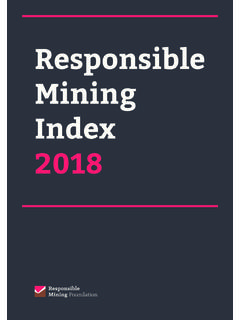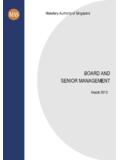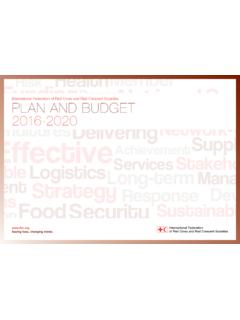Transcription of The FCA s Business Plan 2017-18 - EY - United States
1 The FCA s Business plan 2017 -18 What this means for your firm2 Executive Summary Firms are being challenged by rapidly evolving user needs, as well as heightened uncertainty in the economic and political outlook. Andrew BaileyChief Executive, FCA 2017 /18 is already looking like it will be an eventful year. John Griffith-Jones Chairman, FCA3 FCA Business plan 2017 -18: what this means for your firm | The FCA has published its annual Business plan , the finalised Mission document setting out its high level approach to regulation and, for the first time, its Sector Views. It has done so against a backdrop of considerable change for the regulator and for the industry. There are only 88 weeks from the publication of the FCA s 2017 /18 Business plan until the beginning of 2019. By this time, FS firms will need to have, depending on their market: Executed their ring-fencing plans Gained relevant authorisations Executed transformational Business and operational change under MiFID II Implemented PRIIPs and IDD Complied with GDPR legislation Implemented the Senior Manager and Certification Regime Created open banking environments to comply with PSDIIThis is by no means an exhaustive list.
2 As well as overseeing the implementation of these items, the UK regulators will also be heavily engaged working on the implications of Brexit, including the Great Repeal Bill, reconfiguring future supervisory relationships with overseas regulators, and supporting the industry through transition to the new arrangements, to manage financial stability, market and consumer risks. At the same time, both regulators and firms will be adapting to a rapidly evolving financial services market, driven by huge demographic changes and technology is, therefore, not surprising that the priorities remain consistent to the previous year. The focus and tone of the FCA throughout the Business plan and supporting documents remains consumer, firm and market Liver EY Global Regulatory Reform+44 (0)7717 736 246 Firms face a demanding regulatory implementation agenda, at a time of transformational demographic and technology-driven change, and in an uncertain broader economic and political environment.
3 The FCA is looking to close out historical issuessuch as PPI, progress a range of key market initiatives andincrease focus on culture and governance , and on new risks, in particular, cyber. The FCA will also need to flex priorities to respond as the UK political situation and Brexit negotiation outcomes become clearer. Regulation is already a top priority for Boards and senior management and this plan demonstrates why that should and will remain the case. John Liver EY Global Regulatory Reform4 A critical aspect of promoting competition is to ensure markets stay open to new entry and innovation. We have powers to enforce the prohibitions under UK and EU competition law on anti-competitive agreements and conduct in relation to the provision of financial services. FCA Our Mission 2017 5 FCA Business plan 2017 -18: what this means for your firm | Nonetheless, there are clear areas of new or increased priority in this year s plan , including the significantly increased recognition of cyber threats, the enhanced focus on access and consumer vulnerability and the use of market studies and competition powers to investigate practices and Business models, and drive market-wide change.
4 These tools are increasingly central to the FCA s interventions to secure its objectives. The proposed review of retail banking is the newest focus area although actions following reviews in asset management, insurance, wholesale markets, consumer credit and elsewhere are likely to have far-reaching consequences for those markets. In our view, firms should look afresh at competition as a regulatory and Business model question rather than purely an area of legal challenge. Expect also to be increasingly engaging with competition teams rather than supervisory contacts as new areas of regulatory activity are driven out of the FCA s Strategy & Competition (S&C) Division. The Mission is an important high-level document, aiming to explain how the FCA views its role and its approach to issues it needs to consider in its decision-making, including its remit, the impact it can make, and the needs of users of financial services.
5 There is a clear intention to focus effort on vulnerable customers, which firms should be incorporating into their Business planning and controls. Further papers promised for this year on the FCA s approaches to its key processes, and to critical policy areas, including competition and consumers will provide important opportunities for the industry to contribute to the evolution of UK regulation. The inaugural Sector Views publication to be published annually from this point provide useful context and insights into where the FCA believes markets are, and equally, are not, working well and therefore where future intervention may alsoBusinessservicesproductssectorConduc tcompetitionmay workprioritiesinvestmentprotectionnewRet ailincludingnumberSectoradviceneedpotent ialpensionleadkeydifferentrangeriskscont inueinformationPlanmakemoneyconductmanag ementwholesalebanks valueaccountcultureimproveinnovationpart icularlydebtstandardsincreasesectorsindu stryinsuranceaccessriskretailregulatoryc ustomersdataobjectivessignificantchanget echnologyresilenceconsumersViewsFirmsimp actidentitypaymentspolicyprovidetakebank ingcreditensure2017/18increasedinvestmen tsglobalcostsrulessupportappropriatearou ndFCAcrimeincreasingvulnerblefocusintegr itysystemsissuesregulationUKneedschanges providesMarketincomebusinessactivitiesle velsinvestorscontrolswhetherreviewlendin g years
6 Lesspooreconomyconsumersavingsgroupscurr entwellwayroleaccessaccountsoutcomesgove rnanceareasretirementeffectiveincludeexi stingpartaccrosshelpmanagersindivdualswi thinpricefirms2017/18 Business plan and Sector Views67 FCA Business plan 2017 -18: what this means for your firm | ContentsSection 1 EY thematic cross-sector insights 09 Firm s culture and governance 10 Financial crime and anti-money laundering (AML) 11 Promoting competition and innovation 12 Technological change and resilience 13 Treatment of existing customers 14 Consumer vulnerability and access 15 Section 2 EY industry sector insights 17 Wholesale financial markets 18 Investment management 20 Pensions and retirement income 21 Retail banking 22 Retail lending 23 General insurance and protection 24 Retail investments 25 Section 3 FCA s market based work programme and upcoming European regulation 2619EY thematic cross-sector insights10EY thematic cross-sector insights | 1 What this means for your firm:Banking SM&CR.
7 Demonstrate that changes to governance structures result in better cultural outcomes and track improvements in accountability and culture (most banks have clearly articulated a cultural tone from the top, but have not tested how this translates to the day-to-day practices of employees). Assess your implementation of SM&CR through scenario testing. For example, ask yourself for a given event, would your Management Responsibility Maps and Certification hold up against regulatory investigation? Would you be able to demonstrate reasonable steps? How easy is it to obtain the necessary evidence? Implement the conduct rules training requirements and notification of SM&CR for all staff (other than ancillary staff), and be able to demonstrate accountability at all levels of your extension across financial services: Prepare for proposed implementation from 2018, using lessons learnt from banking and insurance to date.
8 Assess the current state appropriateness of processes and control frameworks (identification of the senior manager significant-harm function (SHF) population as well as the assessment of staff against the requirements at all stages of the employee life cycle are areas where you may require more reflection).Remuneration and performance incentives: Consider how remuneration policies link risk and individual reward to discourage excessive risk taking, and how they encourage positive behaviours and improve SM&CR one year on The FCA has emphasised that embedding SM&CR and driving the culture of individual accountability will take time. It will continue to use Statements of Responsibility (SoRs) and Management Responsibility Maps as part of BAU supervisory programmes, expecting clear understanding of responsibilities.
9 From 17 March 2017 , the requirements for certifying employees and the development of regulatory reference processes now reside with firms, posing a new extension across the market During Q2 2017 , the FCA will be consulting with industry on proposals for the extension of SM&CR to asset managers and insurers, with implementation from 2018. This is likely to be phased and principles-based, focusing on conduct and insurers will have implemented the Senior Insurance Managers Regime (SIMR), they will need to prepare for the Certification Regime requirements over the next 12 months. For insurance intermediaries, SM&CR represents a new set of material and performance incentivesA firm s culture is crucial in ensuring that consumers are at the heart of the Business strategy, with incentives and performance management key drivers of this.
10 During the 2016 17 banking remuneration round, expectations of level one firms included greater transparency at the bonus pool determination level and individual employee outcomes. Level two and three banks, together with asset managers and insurers, can gain insights of expectations from the FCA s approach to level one firms. Culture remains at the heart of how the FCA assesses firms. The FCA s view is that governance and remuneration are key drivers that form a firm s culture. From a governance perspective, the introduction of Senior Manager and Certification Regime (SM&CR) has compelled firms to review their governance and accountability models, with the FCA s focus now turning to how firms have implemented the regimes rather than what they have implemented. That focus will extend across financial services over the next 12 months.










